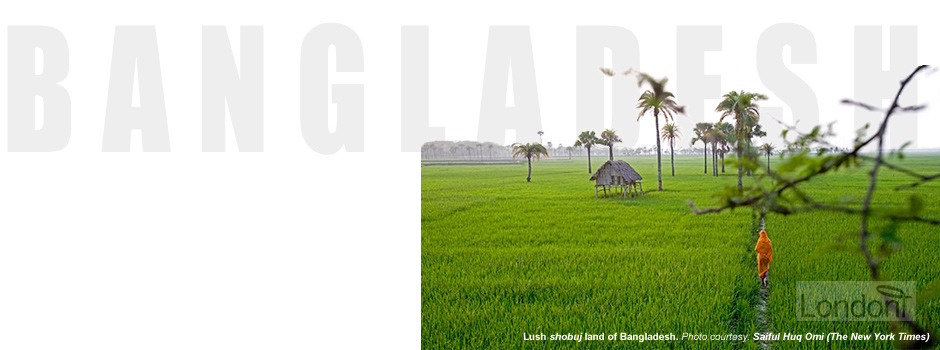
Map of Bangladesh
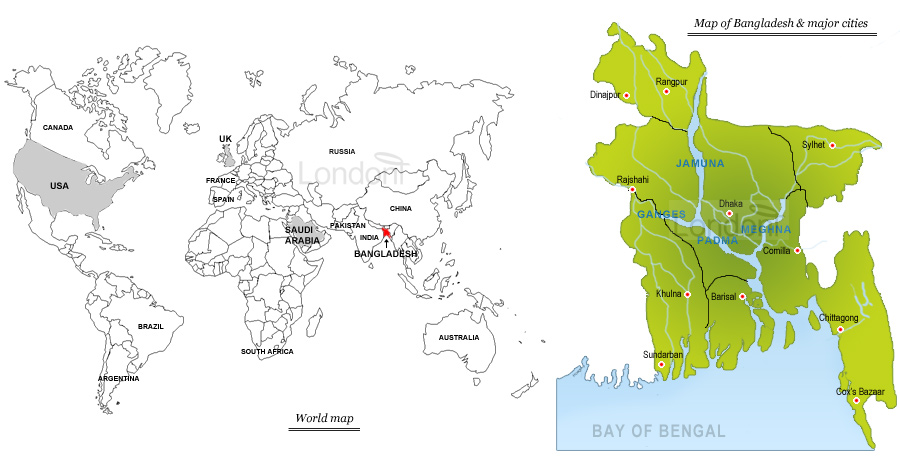
Backgound information
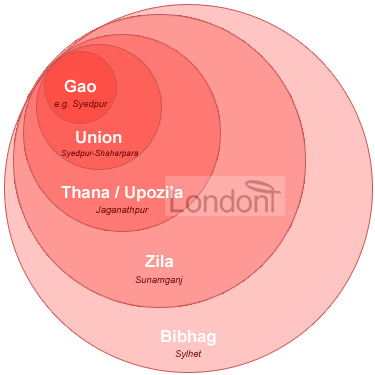
- Islam 4th most largest population of Muslims in the world
- Next Eleven or N-11 nation Identified in 2005 by Goldman Sachs as one of the eleven nations with the biggest economic potential after Brazil, Russia, India, China & South Africa ('BRICS')
- Member of The Commonwealth (aka Commonwealth of Nations or British Commonwealth) 54 countries once ruled by the British now working for common goals (i.e. promotion of democracy, human rights, good governance, the rule of law, individual liberty, equality or egalitarianism, free trade, common national goals or multilateralism, and world peace) set out in the Singapore Declaration of 1971.
- Gao → Union → Thana → Zila → Bibhag - Few villages or Gao make a Union
- few unions == Thana / Upazila (subdistrict)
- few thanas == Zila (district) and controlled by one police station
- few zilas == Bibhag (Division)
- 7 bighag == Bangladesh: Barisal, Chittagong, Dhaka, Khulna, Rajshahi, Rangpur, and Sylhet.
-
1947: Partition of British India into India, West Pakistan and East Pakistan
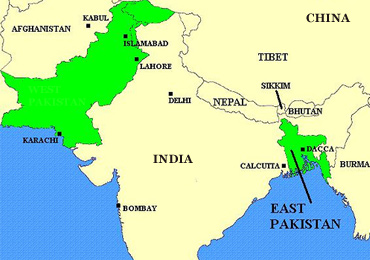
On 14 August 1947, the British Raj's rule in India came to an end after 89 years of colonial rule (from 1858 to 1947). The partition of British India into secular India and Islamic Pakistan was mainly on communal ground with the vast majority of Muslims split into West and East Pakistan to the either side of mainland India.
East Pakistan, originally termed East Bengal (after splitting from Kolkata and 'West Bengal' briefly between 1905 and 1911 - referred to as Bongobangha), was three times as small as West Pakistan in geographical size but roughly twice the population - East Pakistan had 44 million whilst West Pakistan had 25 million people.
Political power and economic benefits were mainly concentrated in West Pakistan and it was widely perceived that East Pakistan was being exploited economically as it was a haven for agriculture.
These growing tensions would later result in the split of East Pakistan into an independent country - BANGLADESH.
1952: Bhasha Andolon & Ekushey February
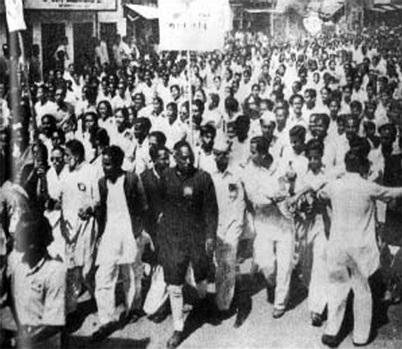
In 1947, efforts were underway to introduce a state language of newly formed Pakistan. A national education summit in Karachi advocated Urdu - then spoken by 3% of the population - as the only state language. Bangla (spoken by the 56% of the country) and Punjabi (28%), the majority language of east and west Pakistan respectively, were both overlooked.
Bangla was removed from the list of approved subjects as well as from currency notes and stamps and recruitment tests for the navy. This lead to protest by students from Dhaka University.
In the height of unrest, Pakistan's first Governor-General, Mohammad Ali Jinnah, declared "Urdu and no other language" would be the common language for all Pakistan citing the language problem was designed by 'fifth column' (i.e. internal mischief makers) to divide Pakistani Muslims. His views were supported by Khwaja Nazimuddin, a Bengali, when he became Prime Minister of Pakistan.
The language controversy eventually reached a boiling point where East Pakistan revolted while the other part of Pakistan remained calm. Several students and civilians lost their lives in a police crackdown on 21 (Ekushey) February 1952 at the University of Dhaka. They became the first people in the world to give their life for their mother tongue.
Ekushey February is revered as the 'Shaheed Dibosh' (Language Martyrs' Day), and the Shaheed Minar was built to remember those killed. In 1999 UNESCO declared 21st February as 'International Mother Language Day' in memory of the 1952 Bangladesh killings for the whole world to celebrate the importance of language.
Read more about Bangladesh Language Movement (1947 - 1952)
1970: Bhola Cyclone
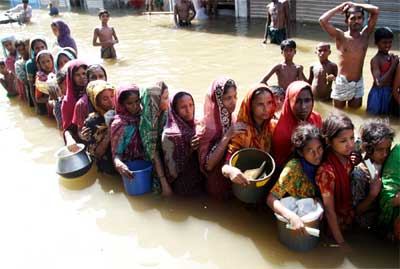
On 12 November 1970, tens days into the fasting month of Ramadhan, the south coast of Bangladesh (then East Pakistan) was flooded by one of the deadliest tropical storm on record and hit with wind travelling at 115mph (185km/h).
The most affected region was Barisal where over 45% of it's population was killed. It is estimated over half a million people died.
The first concert in world history was held to raise awareness of this human tragedy. It was held by Indian sitar maestro Ravi Shankar and British ex-Beatle George Harrison.
The lack of relief effort of President Yahya Khan would further increase the conflict between the two wings of Pakistan and would lead to the Bangladesh Liberation War four months later.
This is one of the first times that a natural event helped to trigger a civil war.
Read more about Bhola Cyclone (1970)
1971: Muktijuddho / Swadhinata Juddho / Sangram
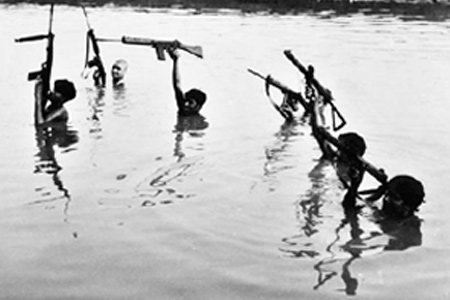
After 23 years of economic, social and political grievances, tensions erupted in the eastern wing of Pakistan especially after they were denied their democratic electoral victory in 1970.
War broke out on the midnight of 25 March 1971 after the Pakistan Army, backed by Muhajir-dominated power elite of West Pakistan, attacked students, civilians and officers in Dhaka in a military operation termed 'Operation Searchlight'.
This lead to nine months civil war between the mighty Pakistan Army and its Bengali collaborators, the Razakars, versus the guerrilla warfare of Mukti Bahini (Liberation Army) and Muktijuddhas (Freedom Fighters), made up of Bengali military, paramilitary, and civilians.
Sea of refugees (estimated to be about 10 million) flooded into eastern province of India and an estimated 3 million Bengalis were killed (including over 1,000 intellectuals) and over 200,000 women and girls were raped - though the exact number are contestable - in one of the worst atrocity of the 20th century.
India provided economic, military and diplomatic support to Mukti Bahini and officially entered the war on 3 December 1971 after Pakistan attacked it's western border. Victory was achieved 13 days later, on 16 December 1971, after the Mitro Bahini (allied forces of Indian army and Mukti Bahini) defeated the West Pakistani forces deployed in the East.
In Bangladesh, 26th March is revered as 'Swadhinata Dibosh' (Independence Day) whilst 16th December is celebrated as 'Bijoy Dibosh' (Victory Day). The Jatiyo Smriti Shoudho, the Rayer Bazar, and Muktijuddho Jadughar are few of the monument and organisation set up to remember this momentous event and sacrifice.
Read more about Bangladesh Liberation War (1971)
1974: Bangladesh famine
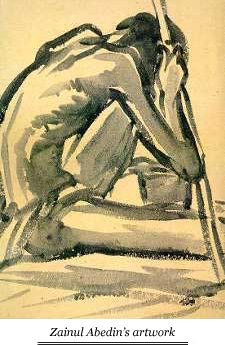
From April to July 1974, Bangladesh was hit by heavy rainfall and a series of devastating floods along the Brahmaputra river causing devastation to crops and killing thousands of people in the process.
Rice crops were devastated and prices rocketed. The poor, labourers and non-landowners were the most vulnerable. Widespread starvation was reported in the Rangpur district, south of Bangladesh - one of the worst affected areas. And this, along with the devastation caused to the country, infrastructure and economy during the Muktijuddho two and half years ago meant Bangladesh was not prepared to deal with the situation.
Neighbouring India too had declined to cooperate with the government of Bangladesh and the USA had withheld 2.2 million tonnes of food aid to 'ensure that it abandoned plans to try Pakistani war criminals' and prevent Bangladesh from exporting jute to Cuba - their local enemy. When Bangladesh did cooperate with the USA by stopping jute export to Cuba it was too late for the famine victims. The damage was done.
An estimated 1.5 million people died.
This Bangladesh famine of 1974 is considered one of the worst in world history. It is only eclipsed by the Bengal famine of 1943 where over 3 million people died, and in 1770 where over 10 million were killed.
Inna-lillahi-wa inna illahi rajiun.
1975 - 81: Assassination of Bangabandhu & Shaheed Zia
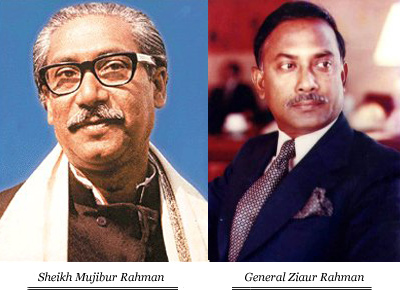
Sheikh Mujibur Rahman, fondly referred to as Bangabandhu (Friend of Bengal), was a founding member and later the leader of Awami League who became the first President of Bangladesh in 1971. He was also the first to change the name of the country from 'East Pakistan' to 'Bangladesh'.
However, post independence and in the face of continuing economic hardship and mounting public disorder, Sheikh Mujib introduced the 'one-party system' in 1974 (thereby preventing other parties from election).
On 15 August 1975, Sheikh Mujib and 20 members his family and associate were assassinated by young, rebel army officers in Dhaka. Only his two daughters who were away in West Germany survived. The elder daughter, Sheikh Hasina Wazed, would later become the Prime Minister of Bangladesh.
Following Sheikh Mujib's assassination army chief General Ziaur Rahman, fondly referred to as Shaheed Zia (Martyred Zia), took over after a short period of coup and counter coup which included murder of four founding members of the Mujibnagar Shorkar, the first government of Bangladesh who led the Bengalis during Muktijuddho.
Ziaur Rahman, who during the 1971 Muktijuddho aged 35-years old declared Independence of Bangladesh on behalf of Sheikh Mujibur Rahman, founded the Bangladesh Nationalist Party (BNP) and later became 7th president of Bangladesh in 1977.
On 30 May 1981, General Zia, his six bodyguards and two aides were assassinated in Chotrogram whilst staying in Chittagong Circuit House by dissident group of the army. The conspirators were either taken into custody or killed. General Zia's wife Khaleda Zia later become the first female Prime Minister of Bangladesh.
Both Sheikh Mujib's Awami League and Ziaur Rahman's BNP dominate the political scene of Bangladesh.
Read more about Sheikh Mujibur assassination (1975)
Read more about Ziaur Rahman assassination (1981)
2011: Cricket World Cup held in Bangladesh
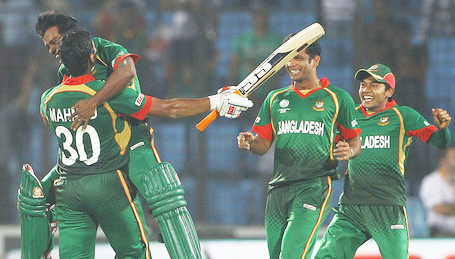
The 10th Cricket World Cup was held in Bangladesh in partnership with India and Sri Lanka.
The opening ceremony was held in Bangabandhu Stadium, Dhaka and viewed by a global audience of over 1 billion. The opening match was played between Bangladesh and India with India - who would go on to win the world cup - only beating Bangladesh by 87 runs (Bangladesh scored 283 in reply to India's 370).
Bangladesh narrowly missed out on the quarter finals too due mainly to a woeful performance against West Indies. However, Bangladesh continued their giant killing instinct by beating England in the group stages in a thrilling encounter in Chittagong - with only 6 balls left to achieve their target score.
They had previously beat India by 5 wickets in 2007 (West Indies) and Pakistan by 62 runs in 1999 (England).
The 2011 tournament was only Bangladesh's fourth appearance in the World Cup since gaining test status in 2000 and the first time in the short but turbulent history of Bangladesh that such a major spectacle was held.
Read more about 10th Cricket World Cup (2011)
Discover more...
Read full history of Bangladesh.
For latest Bangladesh news and information go to Bangladesh's official website or visit BBC's Bangladesh news page.
-
...emblem:
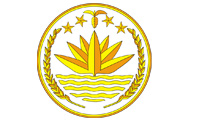
National flower Shapla (water Lily) surrounded by two sheaves of rice, four stars and a bud with three tender leaves
...flag: Jatiyo Potaka

The green of the fertile land with the red blood of the martyrs of Muktijuddho (1971 Liberation War)
...parliament: Jatiyo Sangsad Bhaban
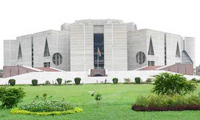
Situated at the center of Dhaka city, it is an architectural wonder. Designed by famous Jewish-American architect Louis Isadore Kahn and his Bengali student Muzharul Islam
...memorial: Shaheed Minar
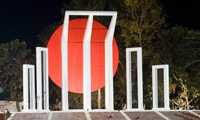
Commemorates Bhasha Andolon (Language Movement of 1952). Third version after first two destroyed. Ekushey February is UNICEF's International Mother Language Day
...monument: Jatiyo Smriti Shoudho
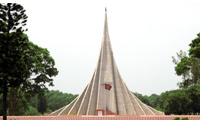
Reminder for those who sacrificed their lives for the independence. Situated at Savar, north-west of Dhaka
...flower: Shapla (Water Lilly)
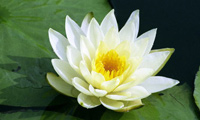
Found in almost every water body in the country
...fruit: Kathal (Jackfruit)
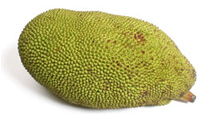
Thorny in outlook this fruit is big in size. It's juicy and delicious but very sticky
...animal: Royal Bengal Tiger
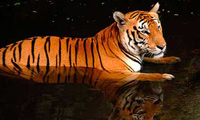
Finds its home in mangrove forests of the Sundarbans in the south-western part of the country. Slowly becoming extinct due to poaching
...bird: Doel (Magpie Robin)
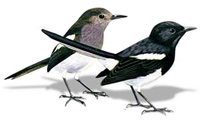
Famous for its sweet look and melodious whistle, the Doel is found everywhere especially in rural Bangladesh
...sport: Kabaddi (a.k.a. Hadudu)
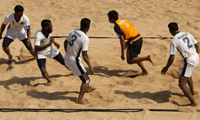
Football, cricket, badminton and karrom are more popular though.
Jatiyo Sangeet (Bangladesh national anthem)
Amar Shunar Bangla (My Golden Bengal)
- Created by Rabindranath Tagore in 1905 to unify Bengalis post Partition of Bengal ("Bongobhanga") into East Bengal (mainly Muslim) & West Bengal (mainly Hindu) by British Viceroy of India, Lord Curzon, in 16th October 1905
- Original music by Indira Devi, Tagore's niece, Satyendranath Tagore's daughter, jotted down the musical notation after hearing it from Tagore himself
- English translation by Syed Ali Ahsan
- First used in 1972
- Hasani? Didn't know that! Only the first 10 lines of this song constitute the national anthem of Bangladesh. Robindronath is the only person ever to have written two national anthems (including India's Jana Gana Mana)
In Bangla

Transliteration
Amar sonar Bangla,
Ami tomae bhalobashi.
Chirodin tomar akash,
Tomar batash,
Amar prane bajae bãshi.
O ma,
Phagune tor amer bone
Ghrane pagol kôre,
Mori hae, hae re,
O ma,
Ôghrane tor bhôra khete
Ami ki dekhechhi modhur hashi.
Ki shobha, ki chhaea go,
Ki sneho, ki maea go,
Ki ãchol bichhaeechho
Bôţer mule,
Nodir kule kule!
Ma, tor mukher bani
Amar kane lage,
Shudhar môto,
Mori hae, hae re,
Ma, tor bôdonkhani molin hole,
Ami nôeon jôle bhashi.In English
My Bengal of Gold,
I love you.
Forever your skies,
Your air set my heart in tune
As if it were a flute.
In spring, O mother mine,
The fragrance from your mango groves
Makes me wild with joy,
Ah, what a thrill!
In autumn, O mother mine,
In the full blossomed paddy fields
I have seen spread all over sweet smiles.
Ah, what beauty, what shades,
What an affection, and what tenderness!
What a quilt have you spread
At the feet of banyan trees
And along the banks of rivers!
O mother mine, words from your lips
Are like nectar to my ears.
Ah, what a thrill!
If sadness, O mother mine,
Casts a gloom on your face,
My eyes are filled with tears! -
Bangladesh Government
Official website: www.bangladesh.gov.bd
Prime Minister of Bangladesh website: www.pmo.gov.bd
President of Bangladesh website: www.bangabhaban.gov.bdElection in Bangladesh
- Name of Parliament Jatiyo Sangshad
- Parliament housed in Jatiyo Sangshad Bhaban
- Term duration 5 years
- Members of Parliament (MP) 345: 300 chosen by public vote, 45 reserved for women chosen by ruling party.
- Last election (2008) result Awami League 230 seats
Bangladesh National Party 29 seats
Jatiya Party 27 seats
Jamaat-e-Islami 2 seats - President (Rashtopoti) Elected by Parliament
- Current Speaker of Jatiyo Sangshad Shirin Sharmin Chaudhury
-
This site is made for you. Help keep the content fresh, relevant and functional by reporting any error.
-
-
Please note: This section is currently being updated. Thank you for your patience.
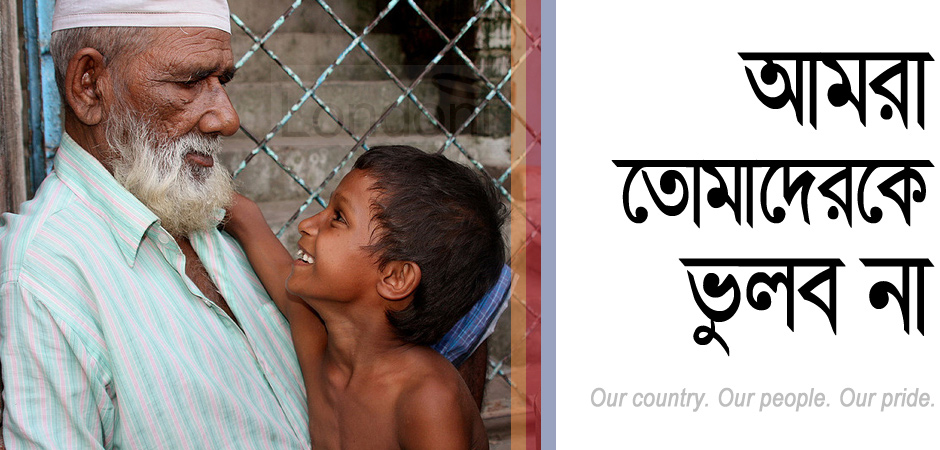
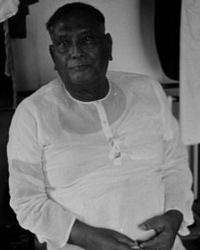 Abul Kashem Fazlul Huq (Sher-e-Bangla) (26 Oct 1873 - 27 Apr 1962) Statesman, public leader who held various high political posts including Mayor of Calcutta (1935), Chief Minister of Undivided Bengal (1937 – 1943) and East Bengal (1954), Home Minister of Pakistan (1955) and Governor of East Pakistan (1956 – 58). Born in Saturia, Barisal division, Bangladesh. Only son of Muhammad Wazid, a reputed civil and criminal lawyer of the Barisal Bar, and Saidunnissa Khatun. Grandfather Kazi Akram Ali was a good Arabic and Persian scholar and a prominent muktar of Barisal. Graduated with triple honours in Chemistry, Mathematics and Physics (1894) from Presidency College, MA degree in Mathematics (1896) from University of Calcutta, and Law Degree (1897) from University Law College, Calcutta. Started legal career as apprentice under Sir Asutosh Mukerjee, but returned to Barisal and started legal practice after death of father. Worked as part-time lecturer of Raj Chandra College (1903-1904) and entered government service as a Deputy Magistrate in 1906. Founding member of All India Muslim League at Dhaka on 30 December 1906, and founder of Krishak Praja Party (1935) campaigning for peasant rights. Drafted Lahore Resolution (1940) which ultimately led to new nation of Pakistan. Honorary title of 'Sher-e-Bangla' (The Tiger of Bengal) and lovingly referred to as 'Huq Saheb'. Retired from politics around 1958 and died four years later in Dhaka. Buried alongside Huseyn Shaheed Suhrawardy and Khwaja Nazimuddin at Shahbag in mausoleum known as 'Teen Netar Mazar' (Mausoleum of Three Leaders). Funeral drew crowd of half a million. Throughout Bangladesh, various educational institutions (e.g. Barisal Sher-e-Bangla Medical College), roads, neighborhoods (Sher-e-Bangla Nagar, which houses National Parliament), and stadiums (Sher-e-Bangla Mirpur Stadium) named after him. Islamabad's A.K.M. Fazl-ul-Haq Rd named after him. Married three times: first wife Khurshid Begum with whom he had two daughters, the marriage ended in divorce. Second wife was Musammat Jannatunissa Begum from Howrah, West Bengal, and they had no children. Third wife Khadija from Meerut district, Uttar Pradesh, with whom he had a son, A. K. Faezul Huq, who played an active role in Bangladeshi politics.
Abul Kashem Fazlul Huq (Sher-e-Bangla) (26 Oct 1873 - 27 Apr 1962) Statesman, public leader who held various high political posts including Mayor of Calcutta (1935), Chief Minister of Undivided Bengal (1937 – 1943) and East Bengal (1954), Home Minister of Pakistan (1955) and Governor of East Pakistan (1956 – 58). Born in Saturia, Barisal division, Bangladesh. Only son of Muhammad Wazid, a reputed civil and criminal lawyer of the Barisal Bar, and Saidunnissa Khatun. Grandfather Kazi Akram Ali was a good Arabic and Persian scholar and a prominent muktar of Barisal. Graduated with triple honours in Chemistry, Mathematics and Physics (1894) from Presidency College, MA degree in Mathematics (1896) from University of Calcutta, and Law Degree (1897) from University Law College, Calcutta. Started legal career as apprentice under Sir Asutosh Mukerjee, but returned to Barisal and started legal practice after death of father. Worked as part-time lecturer of Raj Chandra College (1903-1904) and entered government service as a Deputy Magistrate in 1906. Founding member of All India Muslim League at Dhaka on 30 December 1906, and founder of Krishak Praja Party (1935) campaigning for peasant rights. Drafted Lahore Resolution (1940) which ultimately led to new nation of Pakistan. Honorary title of 'Sher-e-Bangla' (The Tiger of Bengal) and lovingly referred to as 'Huq Saheb'. Retired from politics around 1958 and died four years later in Dhaka. Buried alongside Huseyn Shaheed Suhrawardy and Khwaja Nazimuddin at Shahbag in mausoleum known as 'Teen Netar Mazar' (Mausoleum of Three Leaders). Funeral drew crowd of half a million. Throughout Bangladesh, various educational institutions (e.g. Barisal Sher-e-Bangla Medical College), roads, neighborhoods (Sher-e-Bangla Nagar, which houses National Parliament), and stadiums (Sher-e-Bangla Mirpur Stadium) named after him. Islamabad's A.K.M. Fazl-ul-Haq Rd named after him. Married three times: first wife Khurshid Begum with whom he had two daughters, the marriage ended in divorce. Second wife was Musammat Jannatunissa Begum from Howrah, West Bengal, and they had no children. Third wife Khadija from Meerut district, Uttar Pradesh, with whom he had a son, A. K. Faezul Huq, who played an active role in Bangladeshi politics. 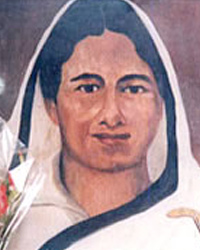 Roquia Sakhawat Hussain (aka Begum Rokeya) (9 Dec 1880 – 9 Dec 1932)
Roquia Sakhawat Hussain (aka Begum Rokeya) (9 Dec 1880 – 9 Dec 1932) 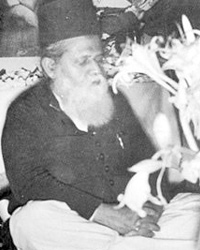 Dr. Muhammad Shahidullah (1885 – 1969) Educationist, writer and linguist. A dormitory in University of Dhaka, 'Shahidullah Hall', named after him. Received degree in Sanskrit (1910) from City College, Kolkata, Master of Arts in Comparative Philology (1912) from University of Calcutta, and PhD from Sorbonne University in France. Translated and edited a number of books including Sindabad Saodagarer Galpa (The stories of the merchant Sindbad, 1922), Bhasa O Sahitya (Language and literature, essays, 1931), Bangala Byakaran (Bengali grammar, 1936), Shikwah O Jawab-i-Shikwah (Questions and their answers, translation from Iqbal, 1942), Rubaiyat-i-Omar Khaiyam (Quatrains of Omar Khayyam, translation, 1942), Essays on Islam (1945), Amader Samasya (Our problems, essays, 1949), Padmavati (Volume I ed, 1950), Bangla Sahityer Katha (History of Bengali literature, Volume I in 1953, Volume II in 1965), Bangala Bhasar Itibrtta (History of Bengali language', 1959), and Qur'an Sharif (The Qur'an, 1963). The dictionary of regional dialects was published under his editorship. Translated 'Charyapada', Buddhist mystic songs from 8th-12th century. Formulating rules for the reformed Bengali calendar. Born in of village Peyara, 24 Pargana, West Bengal, but buried in Shahidullah Hall, beside a mosque on the campus of Dhaka University. Has 7 sons and 2 daughters
Dr. Muhammad Shahidullah (1885 – 1969) Educationist, writer and linguist. A dormitory in University of Dhaka, 'Shahidullah Hall', named after him. Received degree in Sanskrit (1910) from City College, Kolkata, Master of Arts in Comparative Philology (1912) from University of Calcutta, and PhD from Sorbonne University in France. Translated and edited a number of books including Sindabad Saodagarer Galpa (The stories of the merchant Sindbad, 1922), Bhasa O Sahitya (Language and literature, essays, 1931), Bangala Byakaran (Bengali grammar, 1936), Shikwah O Jawab-i-Shikwah (Questions and their answers, translation from Iqbal, 1942), Rubaiyat-i-Omar Khaiyam (Quatrains of Omar Khayyam, translation, 1942), Essays on Islam (1945), Amader Samasya (Our problems, essays, 1949), Padmavati (Volume I ed, 1950), Bangla Sahityer Katha (History of Bengali literature, Volume I in 1953, Volume II in 1965), Bangala Bhasar Itibrtta (History of Bengali language', 1959), and Qur'an Sharif (The Qur'an, 1963). The dictionary of regional dialects was published under his editorship. Translated 'Charyapada', Buddhist mystic songs from 8th-12th century. Formulating rules for the reformed Bengali calendar. Born in of village Peyara, 24 Pargana, West Bengal, but buried in Shahidullah Hall, beside a mosque on the campus of Dhaka University. Has 7 sons and 2 daughters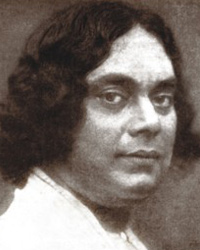 Kazi Nozrul Islam (24 May 1899 – 29 Aug 1976) National poet of Bangladesh. Given popular title of 'Bidrohi Kobi' (Rebel Poet). Mixed career including muezzin (caller of prayer) at local mosque, officer in British Indian Army, and journalist in Kolkata. Wrote and composed music for his nearly 4,000 songs (including gramophone records), collectively known as 'Nazrul geeti' (Nazrul songs). Awarded Jagattarini Gold Medal (1945) — highest honour for work in Bengali literature by the University of Calcutta — and Padma Bhushan (1960), one of India's highest civilian honours. Awarded Swadhinata Purushkar, Bangladesh's highest state award, in the first year of the award (1977). At the age of 43 (in 1942) he began suffering from an unknown disease, losing his voice and memory. Born in village of Churulia, West Bengal but died in Dhaka. Married a Hindu woman, Pramila Devi, and had 4 sons (Krishna Mohammad, who died premature, Bulbul, Sabyasachi, and Aniruddha).
Kazi Nozrul Islam (24 May 1899 – 29 Aug 1976) National poet of Bangladesh. Given popular title of 'Bidrohi Kobi' (Rebel Poet). Mixed career including muezzin (caller of prayer) at local mosque, officer in British Indian Army, and journalist in Kolkata. Wrote and composed music for his nearly 4,000 songs (including gramophone records), collectively known as 'Nazrul geeti' (Nazrul songs). Awarded Jagattarini Gold Medal (1945) — highest honour for work in Bengali literature by the University of Calcutta — and Padma Bhushan (1960), one of India's highest civilian honours. Awarded Swadhinata Purushkar, Bangladesh's highest state award, in the first year of the award (1977). At the age of 43 (in 1942) he began suffering from an unknown disease, losing his voice and memory. Born in village of Churulia, West Bengal but died in Dhaka. Married a Hindu woman, Pramila Devi, and had 4 sons (Krishna Mohammad, who died premature, Bulbul, Sabyasachi, and Aniruddha).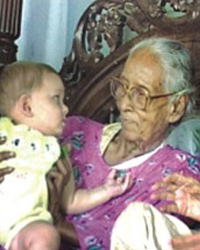 Dr. Zohra Begum Kazi ()
Dr. Zohra Begum Kazi () 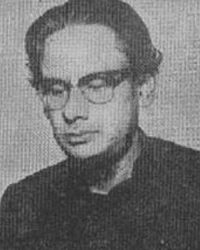 Farrukh Ahmed (10 Jun 1918 – 19 Oct 1974) Poet and writer of children's literature. Strong Islamic belief, both in poetry and personal life, thus referred to as poet of Islamic Renaissance. Born in village of Majhail, Sreepur Upazilla, Magura District in Khulna. Father Khan Sahib Syed Hatem Ali was a Police Inspector. Matriculated from Khulna Zilla School (1937) and completed IA from Ripon College, Kolkata (1939). Enrolled at prestigious Scottish Church College to study BA (Hons) in Philosophy and English Literature, but unable to complete studies. Inspired by radical humanism of Manabendra Nath Roy and participated in leftist politics. Served in the office of IG Prisons for a few years and in the Civil Supply Department in Kolkata. Began editing monthly 'Mohammadi' magazine from 1945. After Partition of India in 1947, came to Dhaka and joined Dhaka Centre of Radio Pakistan as a staff artiste where he directed popular weekly programme for children, named 'Khelaghar' (Playhouse). Became famous for his poem 'Lash' written on 1944 famine. Promoted Muslim awakening and utilised Arabic and Persian words greatly in his poem. Also wrote satrical poems and sonnets. Books include Majhi (1944), Sirazam Munira (1952), Naufel O Hatem (1961), Muhurter Kavita (1963), Hatemtayi (1966), and Habida Marur Kahini (1981). Children works include Pakhir Basa (1965), Harafer Chhada (1970), and Chhadar Asar (1970). Winner of first Bangla Academy Award (1960), President's Award for Pride of Performance (1961), Adamjee Prize (1966), UNESCO Prize (1966), Ekushey Padak (posthumously, 1977), and Swadhinata Puraskar (posthumously, 1980). Supported the Pakistan movement. Despite his Pakistani and Islamic ideals, he supported Language Movement in 1952 and, later, Liberation War of Bangladesh. Died in Dhaka without any medical care and in severe penury. Work promoted by Farrukh Gabeshana Foundation.
Farrukh Ahmed (10 Jun 1918 – 19 Oct 1974) Poet and writer of children's literature. Strong Islamic belief, both in poetry and personal life, thus referred to as poet of Islamic Renaissance. Born in village of Majhail, Sreepur Upazilla, Magura District in Khulna. Father Khan Sahib Syed Hatem Ali was a Police Inspector. Matriculated from Khulna Zilla School (1937) and completed IA from Ripon College, Kolkata (1939). Enrolled at prestigious Scottish Church College to study BA (Hons) in Philosophy and English Literature, but unable to complete studies. Inspired by radical humanism of Manabendra Nath Roy and participated in leftist politics. Served in the office of IG Prisons for a few years and in the Civil Supply Department in Kolkata. Began editing monthly 'Mohammadi' magazine from 1945. After Partition of India in 1947, came to Dhaka and joined Dhaka Centre of Radio Pakistan as a staff artiste where he directed popular weekly programme for children, named 'Khelaghar' (Playhouse). Became famous for his poem 'Lash' written on 1944 famine. Promoted Muslim awakening and utilised Arabic and Persian words greatly in his poem. Also wrote satrical poems and sonnets. Books include Majhi (1944), Sirazam Munira (1952), Naufel O Hatem (1961), Muhurter Kavita (1963), Hatemtayi (1966), and Habida Marur Kahini (1981). Children works include Pakhir Basa (1965), Harafer Chhada (1970), and Chhadar Asar (1970). Winner of first Bangla Academy Award (1960), President's Award for Pride of Performance (1961), Adamjee Prize (1966), UNESCO Prize (1966), Ekushey Padak (posthumously, 1977), and Swadhinata Puraskar (posthumously, 1980). Supported the Pakistan movement. Despite his Pakistani and Islamic ideals, he supported Language Movement in 1952 and, later, Liberation War of Bangladesh. Died in Dhaka without any medical care and in severe penury. Work promoted by Farrukh Gabeshana Foundation.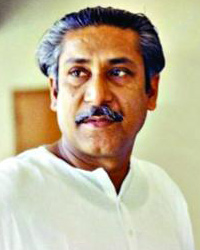 Sheikh Mujibur Rahman (17 Mar 1920 - 15 Aug 1975) 1st President and 2nd Prime Minister of independent Bangladesh. Leader of Awami League. Popularly referred to as 'Bangabandhu' (Friend of Bengal) and 'Jathir Jonok/Pitha' (Father of Nation). Participated in 1952 Bhasha Andolon. Gave the historic 'Ebarer sangram muktir sangram, ebarer sangram swadhinatar sangram' 7 March 1971 speech in Ramna Racecourse (now Suhrawardy Udyan) to inspire a nation to fight for their right. Imprisoned in (West) Pakistani jail for nine-and-half month during Mukhtijuddho. First Constitution of Bangladesh formulated under his leadership. Won Bangladesh's first general election. Creator of the controversial BAKSAL one-party ruling system. Assassinated along with most of his family by rebel officers on 15 August 1975 at family home in Dhanmondi, Dhaka. Daughter Hasina has become PM of Bangladesh on many occassions. Born and buried in Tangail, Dhaka bibhag.
Sheikh Mujibur Rahman (17 Mar 1920 - 15 Aug 1975) 1st President and 2nd Prime Minister of independent Bangladesh. Leader of Awami League. Popularly referred to as 'Bangabandhu' (Friend of Bengal) and 'Jathir Jonok/Pitha' (Father of Nation). Participated in 1952 Bhasha Andolon. Gave the historic 'Ebarer sangram muktir sangram, ebarer sangram swadhinatar sangram' 7 March 1971 speech in Ramna Racecourse (now Suhrawardy Udyan) to inspire a nation to fight for their right. Imprisoned in (West) Pakistani jail for nine-and-half month during Mukhtijuddho. First Constitution of Bangladesh formulated under his leadership. Won Bangladesh's first general election. Creator of the controversial BAKSAL one-party ruling system. Assassinated along with most of his family by rebel officers on 15 August 1975 at family home in Dhanmondi, Dhaka. Daughter Hasina has become PM of Bangladesh on many occassions. Born and buried in Tangail, Dhaka bibhag.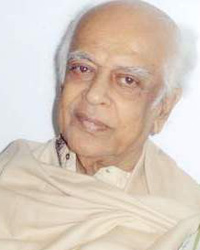 Muzharul Islam ()
Muzharul Islam () 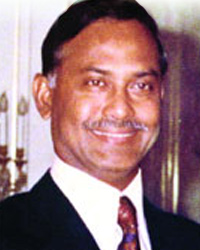 Ziaur Rahman ()
Ziaur Rahman () 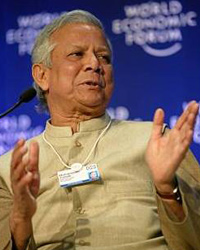 Muhammad Yunus (Born 28 Jun 1940) Bangladeshi economist and founder of Grameen Bank which provides microcredit (small loans to poor people). Both Grameen Bank and Muhammad Yunus won Nobel Peace Prize in 2006 - first Bangladeshi and third Bengali to ever get a Nobel Prize. Born in village of Bathua, Chittagong. Third of nine children of Haji Dula Mia Shoudagar and Sufia Khatun. Father was a jeweler, and mother suffered from psychological illness by 1949. Received degree (1960) and masters (1961) in economics from Dhaka University and appointed lecturer in Chittagong College. Received Fulbright Scholarship in 1965 to study in United States and obtained PhD in economics from Vanderbilt University Graduate Program in Economic Development (GPED) in 1971. Assistant professor of economics at Middle Tennessee State University in Murfreesboro (1969 - 1972). Campaigned in US for Bangladesh's liberation in 1971. Returned home and set up various rural economic program while head of Economics department of Chittagong University. Led to formation of Grameen Bank (Village Bank) in 1983. Won countless awards including Swadhinata Purushkar (1987), US Presidential Medal of Freedom (2009), King Abdul Aziz medal (2007), Ramon Magsaysay Award (1984), World Food Prize (1994), and multiple honorary doctorate degrees from universities across the world (e.g. Argentina, Bangladesh, Belgium, Costa Rica, India, Italy, Japan, Lebanon, Malaysia, Russia, South Africa, UK, USA and Peru). Voted 2nd in Prospect Magazine's 2008 global poll of the world's top 100 intellectuals. In January 2008, Houston, Texas declared 14 January as "Muhammad Yunus Day". Embroiled in controversies regarding microfinance and management role within bank. Married a Bengali after first marriage to a Russian-American ended in separation. A daughter from each of the two marriages. Work now carried out by think tank Yunus centre.
Muhammad Yunus (Born 28 Jun 1940) Bangladeshi economist and founder of Grameen Bank which provides microcredit (small loans to poor people). Both Grameen Bank and Muhammad Yunus won Nobel Peace Prize in 2006 - first Bangladeshi and third Bengali to ever get a Nobel Prize. Born in village of Bathua, Chittagong. Third of nine children of Haji Dula Mia Shoudagar and Sufia Khatun. Father was a jeweler, and mother suffered from psychological illness by 1949. Received degree (1960) and masters (1961) in economics from Dhaka University and appointed lecturer in Chittagong College. Received Fulbright Scholarship in 1965 to study in United States and obtained PhD in economics from Vanderbilt University Graduate Program in Economic Development (GPED) in 1971. Assistant professor of economics at Middle Tennessee State University in Murfreesboro (1969 - 1972). Campaigned in US for Bangladesh's liberation in 1971. Returned home and set up various rural economic program while head of Economics department of Chittagong University. Led to formation of Grameen Bank (Village Bank) in 1983. Won countless awards including Swadhinata Purushkar (1987), US Presidential Medal of Freedom (2009), King Abdul Aziz medal (2007), Ramon Magsaysay Award (1984), World Food Prize (1994), and multiple honorary doctorate degrees from universities across the world (e.g. Argentina, Bangladesh, Belgium, Costa Rica, India, Italy, Japan, Lebanon, Malaysia, Russia, South Africa, UK, USA and Peru). Voted 2nd in Prospect Magazine's 2008 global poll of the world's top 100 intellectuals. In January 2008, Houston, Texas declared 14 January as "Muhammad Yunus Day". Embroiled in controversies regarding microfinance and management role within bank. Married a Bengali after first marriage to a Russian-American ended in separation. A daughter from each of the two marriages. Work now carried out by think tank Yunus centre. Jawed Karim (born in 1979) Founder of YouTube along with Chad Hurley and Steve Chen in 2005. YouTube's first video, Me at the zoo, was uploaded by Karim on April 23, 2005. Many of the core components of PayPal, including its real-time anti-fraud system, were also designed and implemented by Karim. father, Naimul Karim, is a Bangladeshi researcher at 3M. His mother, Christine Karim, is a German scientist and research associate professor of biochemistry at the University of Minnesota. born in Merseburg, East Germany
Jawed Karim (born in 1979) Founder of YouTube along with Chad Hurley and Steve Chen in 2005. YouTube's first video, Me at the zoo, was uploaded by Karim on April 23, 2005. Many of the core components of PayPal, including its real-time anti-fraud system, were also designed and implemented by Karim. father, Naimul Karim, is a Bangladeshi researcher at 3M. His mother, Christine Karim, is a German scientist and research associate professor of biochemistry at the University of Minnesota. born in Merseburg, East Germany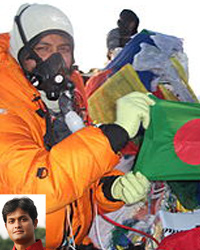 Musa Ibrahim (Born 1979) Bangladeshi mountaineer and a journalist by profession. He is the first Bangladeshi to reach the summit of Mount Everest http://www.thedailystar.net/newDesign/news-details.php?nid=140208. According to Musa, he reached the summit around 6:00am BST on May 23, 2010. Bachelor of Education(B.Ed) degree on Science Education and Master of Education(M.Ed) degree on Educational Evaluation and Research from 'Institute of Education and Research (IER), University of Dhaka. degree on Disaster Management from BRAC University, Dhaka. Born in Noakhali.
Musa Ibrahim (Born 1979) Bangladeshi mountaineer and a journalist by profession. He is the first Bangladeshi to reach the summit of Mount Everest http://www.thedailystar.net/newDesign/news-details.php?nid=140208. According to Musa, he reached the summit around 6:00am BST on May 23, 2010. Bachelor of Education(B.Ed) degree on Science Education and Master of Education(M.Ed) degree on Educational Evaluation and Research from 'Institute of Education and Research (IER), University of Dhaka. degree on Disaster Management from BRAC University, Dhaka. Born in Noakhali.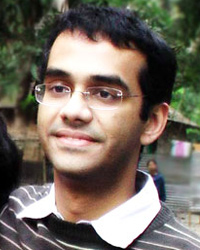 Nafees Bin Zafar () First Bangladeshi to win an Oscar for Scientific and Technical Academy Awards in 2007 http://www.oscars.org/awards/scitech/winners/2007.html for the development of the fluid simulation system at Digital Domain, a visual effects and animation company founded by Titanic film director James Cameron amongst others. applying his mad computer skills to digital effects in movies like The Lord of the Rings: The Fellowship of the Ring and Pirates of the Caribbean: At World’s End. develop visual effects software for DreamWorks film studio. His uncle is architect Syed Mainul Hossain, who designed the Jatiyo Smriti Soudha, the national monument of Bangladesh. http://www.nafees.net/
Nafees Bin Zafar () First Bangladeshi to win an Oscar for Scientific and Technical Academy Awards in 2007 http://www.oscars.org/awards/scitech/winners/2007.html for the development of the fluid simulation system at Digital Domain, a visual effects and animation company founded by Titanic film director James Cameron amongst others. applying his mad computer skills to digital effects in movies like The Lord of the Rings: The Fellowship of the Ring and Pirates of the Caribbean: At World’s End. develop visual effects software for DreamWorks film studio. His uncle is architect Syed Mainul Hossain, who designed the Jatiyo Smriti Soudha, the national monument of Bangladesh. http://www.nafees.net/
More life stories...
important info, tips, hints... ittadhi
- Bangladesh's official tourist board: www.parjatan.gov.bd
- Whilst in Rome...: remember YOU'RE in their country so don't expect to imprint your value system. Go with open mind, be respectful, open to learning. If you disagree with something explain to them your views politely. Unless necessity dictates, refrain from aggressive behaviour.
- Shops opening hours: 11am - 7pm everyday except Friday when they're closed.
- Negotiate C-n-G fares before departing: C-n-Gs are local taxis and they have no fixed fares or systematic way of calculating the fare. They're based on bartering therefore to avoid later dispute and aggression, arrange the price for your journey. Also remember a return journey is much cheaper than a single journey.
- 'Reserved' C-n-G: C-n-Gs can hold upto 5 people, 2 either side of the driver and 3 at the back. Empty spaces are filled with passengers prior to the journey or more passengers are picked up on the way to the destination. If you don't want to share with strangers and want the whole C-n-G to yourself then you can 'reserve' (usually pronounced 're-jab') for extra cost.
- 60% shopping rule: Most shopping items - even those with fixed prices - are negotiable. Shopkeepers will usually request twice the normal price for an item, specially if they suspect you're not a local, therefore bargain with them and settle for 50-60% of their original quote.
- 'Facial' for men at barbers: Getting a haircut followed by the rudimentary head massage and shave is a bliss in Bangladesh! Whilst these are fairly cheap a face wax - known colloquially as 'facial' - is very expensive and time consuming. In some instances it can last upto an hour!
- See-through umbrellas:
- One pair for the Mosque: sandals get 'mistakenly' taken (read robbed)
- Monsoon period: June-August torrential rain in the morning followed by blazing hot sun in the afternoon then more rain in the night. Best time for sports are during colder period of November-February.
- Mosquito bites: regardless of what you do or whether you're in city, town or village you'll get biten pretty much every evening.
- Conservative clothing: men - formal look very professional and classy or 'bodroh' (gentile)
Stay connected.
Londoni is not responsible for the content of external sites.
May Allah bless Bangladesh and our people. Ameen.

